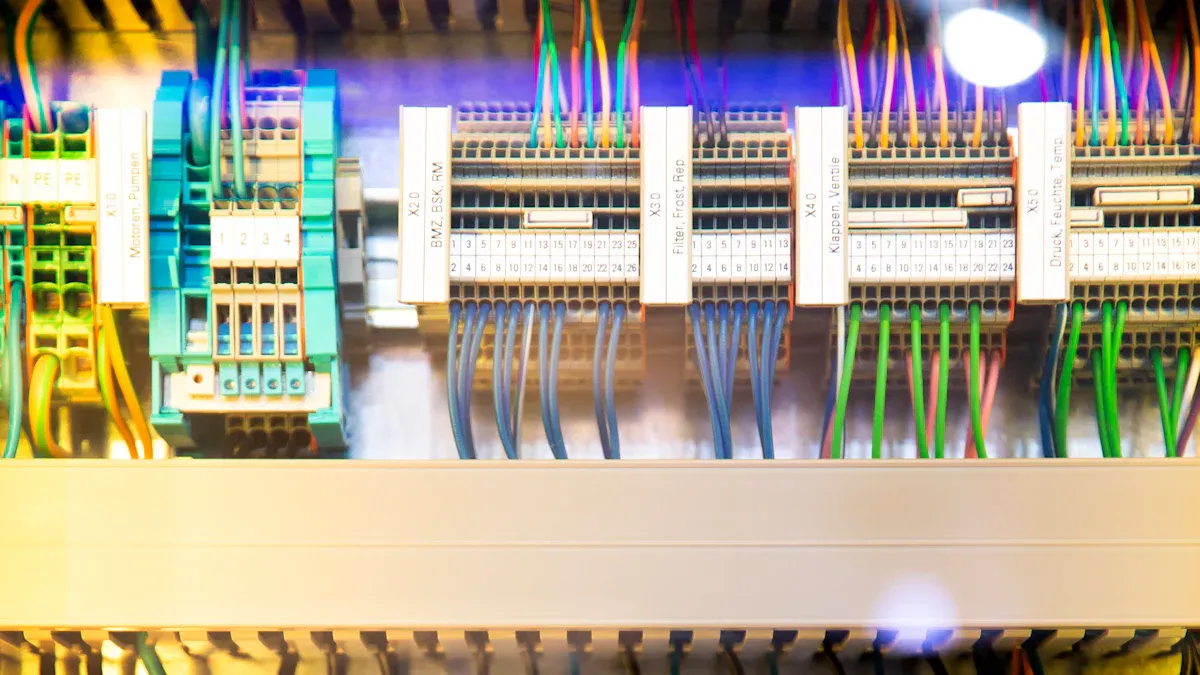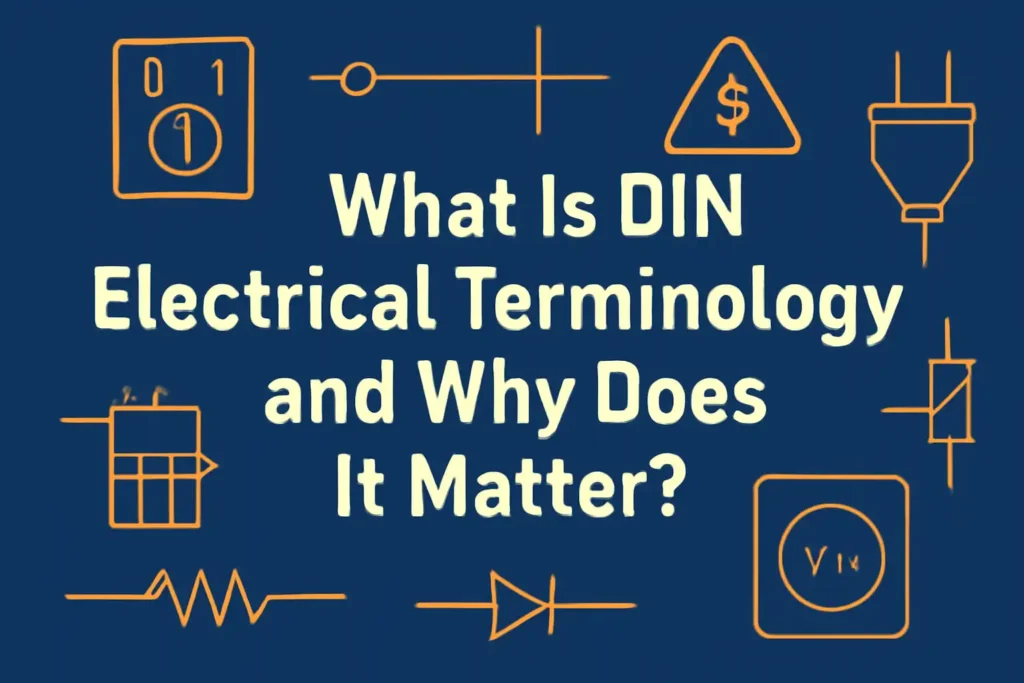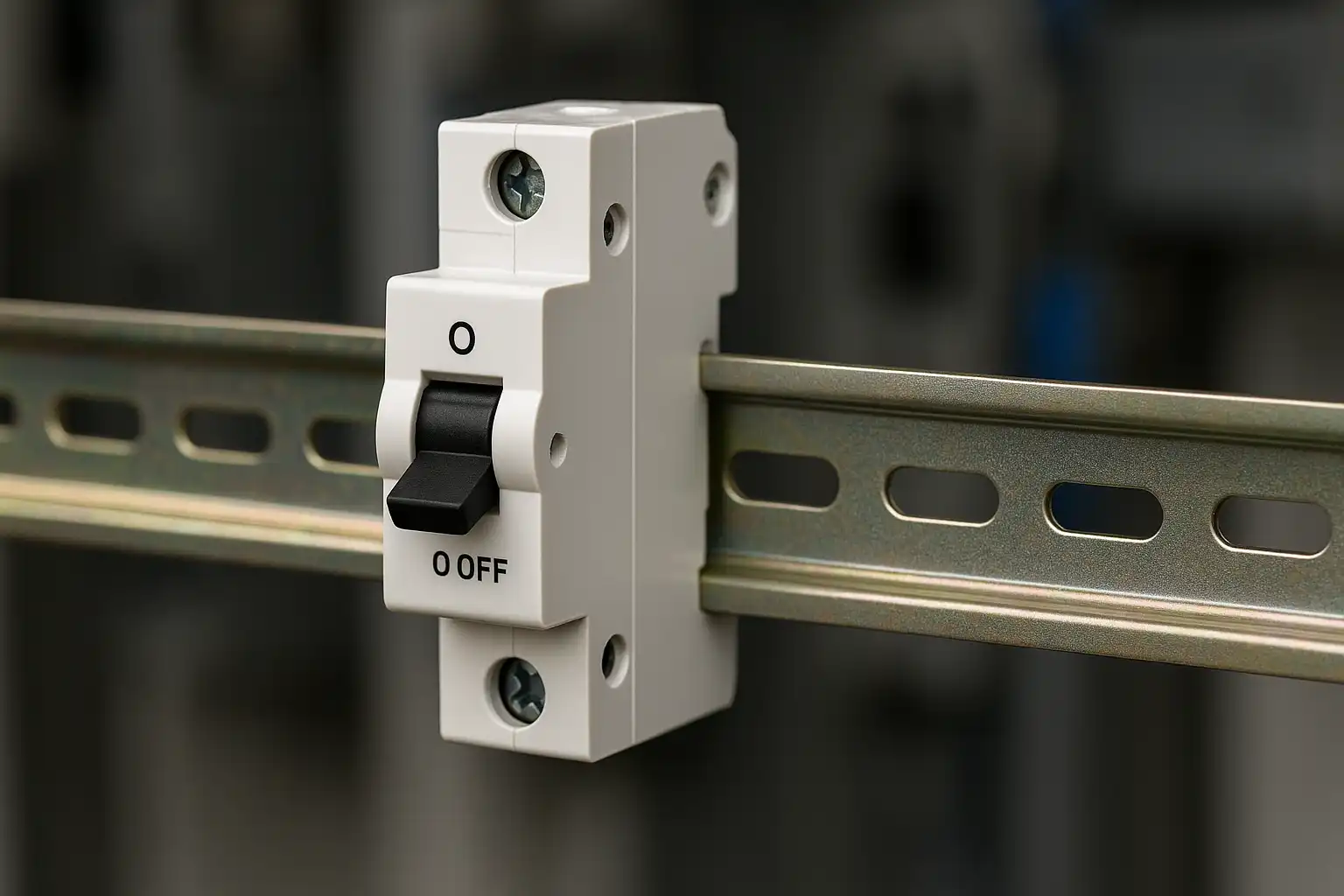DIN electrical terminology is the set of standard words and rules for electrical parts and systems based on DIN standards. This terminology makes sure products follow tough safety rules, like overload protection and better insulation. Professionals use DIN electrical terminology to pick parts that work together. Regular people get safer products and easier repairs. Using these standards helps add new things like digital controls and energy-saving designs. This makes electrical systems safer and better for all people.
Key Takeaways
- DIN electrical terminology gives clear rules and words for electrical parts. This helps keep things safe and makes repairs easier. Using DIN standards lets parts from different brands fit and work together well. This saves both time and money. DIN rails and connectors have set sizes and shapes. This makes putting them in and upgrading them faster and neater. Following DIN rules lowers mistakes and makes things safer. It also helps electrical systems work well everywhere. Knowing DIN terms helps engineers and electricians pick the right parts. It lets them build better and safer systems.
DIN Electrical Terminology Defined
What Is DIN?
DIN stands for the German Institute for Standardization. In German, it is called Deutsches Institut für Normung. This group makes rules for many industries, including electrical engineering. DIN standards tell people how big, what shape, and how well electrical parts should work. These rules help engineers and companies make products that fit together and are safe to use.
DIN standards started in Germany in 1928. At first, they made sure electrical parts, like mounting rails, had the same size and details. Over time, DIN standards became the base for many rules in Europe and other places. Today, DIN standards help companies build electrical systems that are safe, work well, and are easy to fix.
The Verband der Elektrotechnik, Elektronik und Informationstechnik (VDE) is also important for DIN standards. VDE works on electric safety and helps DIN make technical rules. Both groups make sure DIN electrical terminology is current and fits new electrical systems.
Note: DIN electrical terminology gives everyone the same words to use. This helps engineers, electricians, and companies avoid mistakes and confusion when working with electrical products.
Standardization in Electrical Systems
Standardization means using the same rules and sizes for products and how they are made. In electrical systems, DIN standards give clear steps for design, materials, and quality. These standards make sure parts from different companies can work together.
- DIN standards set the size and shape of connectors, rails, and other electrical parts.
- They make sure parts can be used together, even from different companies.
- DIN rails, for example, have set sizes and holes. This makes it easy to put in switches, relays, and other devices from many brands.
A table below shows how DIN standardization helps electrical systems:
| Feature | Benefit |
|---|---|
| Common dimensions | Easy replacement and upgrades |
| Clear terminology | Fewer errors in installation |
| International adoption | Products work in many countries |
| Quality requirements | Safer and more reliable systems |
DIN electrical terminology helps make electrical work safe and efficient. It also lets companies sell products around the world by following the same rules. Over time, DIN standards have been accepted by groups like ISO and IEC. This means DIN-based products can be used in many countries without changes.
DIN electrical terminology has been used more since the 1920s. It started with simple mounting rails and now covers many electrical parts. The growth of these standards shows they help make electrical work easier, safer, and more reliable.
Why It Matters
Safety and Compliance
DIN electrical terminology is very important for safety. When everyone uses the same words and rules, mistakes are less likely. Clear rules help people know what to do for each part. This lowers the risk of accidents or fires. It also helps stop equipment from breaking.
Many countries have strong safety rules for products. In Canada, Health Canada needs a Drug Identification Number (DIN) for drugs. This number shows the product is safe and meets quality rules. Makers must prove their products are safe before selling them. They must keep records and tell about any changes. If they do not follow the rules, they cannot sell the product. These steps show why following standards is important for safety.
Tip: Using DIN electrical terminology helps teams talk clearly. Everyone knows what each word means. This stops confusion and helps people work together.
Compatibility and Efficiency
DIN standards help parts from different brands fit together. They set rules for size, shape, and materials. This lets companies make products that connect without trouble. Installers can use parts from many brands in one system. The parts will fit and work well.
When companies use DIN 31051, they plan maintenance better. This standard helps with preventive and predictive maintenance. These ways stop surprise breakdowns. Equipment lasts longer and works better. Companies save money because they need fewer repairs. They also avoid big problems that stop work.
A table below shows the main benefits of using DIN standards:
| Benefit | Description |
|---|---|
| Improved compatibility | Parts from different brands work together |
| Easier maintenance | Standard parts make repairs faster and simpler |
| Global compatibility | Products can be used in many countries |
| Lower costs | Fewer repairs and less downtime |
DIN electrical terminology also helps stop mistakes during installation. When everyone uses the same words and rules, they can work faster. There are fewer errors. This makes electrical systems safer and more reliable.
Key Terms & Standards

DIN Connectors
DIN connectors can be round or rectangle shaped. They follow certain rules. You can find them in many things. These include audio gear, computers, and machines. There are a few main types:
- Standard DIN connectors are for old computers and analog audio.
- Mini-DIN connectors are smaller. They are used for keyboards and mice.
- Power DIN connectors handle more power. They are used in medical and industrial tools.
- Locking DIN connectors stay in place. They are good for cars and factories.
| Type of DIN Connector | Description | Pin Configurations | Typical Applications | Relevant Standards |
|---|---|---|---|---|
| Standard DIN Connectors | Circular, various pin counts | 3 to 8 pins | Audio, MIDI, keyboards | DIN 41524 |
| Mini-DIN Connectors | Smaller, for compact devices | Various | Keyboards, mice | IEC 60130-9 |
| Power DIN Connectors | High power, robust design | Varies | Industrial, medical | Not DIN-specific |
| Locking DIN Connectors | Locking mechanism for secure fit | Varies | Automotive, industrial | Not DIN-specific |
| Rectangular DIN Connectors | Used for plug-in cards | Varies | Backplanes, motherboards | DIN 41612 |
DIN connectors are known for being strong and lasting a long time. They can handle high speeds and tough places.
DIN Rails
DIN rails are metal bars. They hold electrical parts inside panels. They come in different shapes and sizes:
| DIN Rail Type | Width (mm) | Channel Depth (mm) | Notes on Load Support |
|---|---|---|---|
| Top Hat (TS35) | 35 | 7.5 or 15 | Most common, fits many devices |
| Mini Top Hat (TS15) | 15 | 5.5 | For compact components |
| C-Rails | 32 | N/A | Supports heavy items like transformers |
| G-Rails (TS32) | 32 | Deeper | For heavy-duty components |
People use DIN rails in control panels and building systems. The standard sizes make it easy to add or change parts.
Terminal Blocks
Terminal blocks join wires inside panels. DIN terminal blocks snap onto DIN rails. This keeps wires tidy and easy to find. Some important features are:
- You can change or fix them easily because they are modular.
- End plates and markers help keep things safe and labeled.
- They resist shaking and have good insulation.
- They meet safety rules like UL, IEC, and CSA.
Factories and automation use these blocks for power and control. Their design works well in tough places and helps stop wiring errors.
Numbering Systems
DIN numbering systems give numbers to terminals and parts. This helps workers find things fast. For example:
| Terminal Number | Function Description |
|---|---|
| 15 | Battery positive from ignition switch |
| 30 | Battery positive direct |
| 31 | Return to battery negative or ground |
| 85 | Relay coil – Negative |
| 86 | Relay coil – Positive |
| 87 | Common contact (relay) |
| 50 | Starter control |
Using the same numbers cuts down on mistakes. It also makes fixing things faster. DIN electrical terminology uses these numbers so everyone understands each other.
Practical Uses of DIN Electrical Terminology
Product Selection
When engineers know DIN terminology, picking parts is easier. They can see which parts fit together and are safe. This helps them not make expensive mistakes. It also makes sure systems work right. For example, if someone needs a DIN rail, knowing top-hat and C-rail is important.
- DIN terminology gives set sizes, like 35mm for top-hat rails.
- It lists types, such as slotted or solid rails, and shows certifications like IEC 60715.
- Set sizes mean breakers, relays, and power supplies from any brand will fit.
- Following world rules keeps things safe and parts working together.
- Knowing DIN words helps use space well and keeps wires tidy, stopping dangers.
- DIN rails make it fast to put in and fix parts, so upgrades are quick.
- Using standards lets engineers pick safe and strong parts, making systems better.
Tip: Using the right DIN words when picking parts helps teams talk clearly and stops mistakes with wrong parts.
Installation Scenarios
DIN standards make many jobs easier in different places. The table below shows how these rules help in real life:
| Installation Scenario | Typical Components | How DIN Standards Simplify Installation |
|---|---|---|
| Industrial Automation | Sensors, actuators, automation components | Set rail sizes and mounts make it fast and neat to add parts |
| Power Distribution | Circuit breakers, relays, power meters | Easy mounting and order save time and work |
| Home Automation | Lighting controls, HVAC, security devices | Smart home parts fit together and look tidy |
The Railfix DIN rail adapter is a good example. It lets workers put in full DIN rails without taking off each part. This makes building control cabinets faster and less hard. DIN standards also keep wires neat, so fixing things is easier. Good layouts and clear labels save time and help keep everyone safe.
Knowing DIN standards helps people make safe electrical systems. These rules make it simple to install and fix things. They also help parts work in many countries. Learning DIN wiring diagrams helps with car repairs. If you want to learn more, Academy Europe has free online classes. These classes teach both hands-on and theory lessons about DIN.
- Academy Europe: info@academyeurope.org, +49 174 463 12 55
Learning these words helps you make smart choices and build better systems.
FAQ
What is a DIN rail used for?
A DIN rail holds things like circuit breakers and relays. It keeps these parts inside control panels. The rail gives a simple way to mount and organize parts in electrical systems.
What does the DIN number mean on electrical parts?
The DIN number means a part follows a German rule. This number tells you what size, safety, and fit rules the part meets. It helps people know if the part is right for their system.
What types of DIN connectors exist?
DIN connectors come in different types:
- Standard DIN is used for audio and MIDI.
- Mini-DIN works with keyboards and mice.
- Power DIN is for industrial tools.
- Locking DIN is used in cars. Each type fits certain devices and jobs.
What is the benefit of using DIN terminal blocks?
DIN terminal blocks make wiring simple and safe. They snap onto DIN rails and keep wires neat. You can change or fix wires quickly with these blocks.
What does DIN standardization prevent?
DIN standardization stops confusion and mistakes when installing parts. It makes sure parts from many brands fit and work safely in lots of countries.
The following information may be of interest to you
What should you know about DIN rail circuit breakers for home and industry
Can You Connect Multiple Surge Protectors Together Safely
What is a DIN rail mounted miniature circuit breaker and how does it work
How to Install Circuit Breakers on DIN Rails Step by Step
Top 2 Pole Miniature Circuit Breakers for Home Use in 2025




